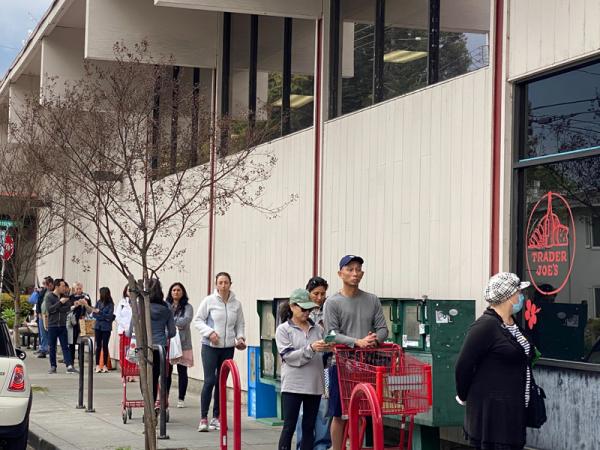KID REPORTERS’ NOTEBOOK
California Has a Message: “Stay Home”


Munveer participates in an online class after his Northern California school closed temporarily due to the coronavirus pandemic.
On March 17, six counties in the San Francisco Bay Area received a shelter-in-place order to help limit the spread of the novel coronavirus. Residents were told to avoid leaving their homes except to get necessities like food and medicine.
Two days later, the order was extended to the entire state of California. Governor Gavin Newsom told all non-essential workers to stay home.
California has a population of nearly 40 million. In New York and Washington State, millions of residents are under similar restrictions.

Shoppers at a Trader Joe’s in Menlo Park, California, maintain social distancing while waiting to buy groceries.
“BE A GOOD NEIGHBOR”
After the coronavirus emerged in China in late 2019, it quickly spread across the globe. To date, there are more than 373,000 confirmed cases worldwide, with nearly 17,000 deaths.
“Social distancing” policies, which are in effect to varying degrees across the country and around the world, are designed to help bring the virus under control. Already, hospitals are overwhelmed. People who may have the virus are unable to receive medical care.
“Be a good neighbor,” Newsom said during a news conference broadcast on Facebook and Twitter. “Be a good citizen. It’s time to wake up and time to recognize it’s not just about the old folks.”
Research now shows that young people can also become sick from COVID-19, the respiratory disease caused by the coronavirus.
A DIFFICULT ADJUSTMENT
People shopping for food in the San Francisco Bay Area are seeing long lines and empty shelves. Many stores are out of such essential supplies as hand sanitizers, toilet paper, and bottled water.
Most businesses are closed, with employees working from home. Restaurants are limited to offering take-out or delivery only.
Even before the statewide closure, many schools had switched to online learning as a precautionary measure. The shift to virtual education has been difficult for some.
“I worry that my students won’t be able to focus on class,” said Shanel Daines, a sixth-grade history teacher at Menlo School in Atherton. It also can challenging for educators to teach courses that were designed for in-person instruction.
Some students say that online learning is not as engaging as being in class. “It’s difficult to not be able to quickly access teachers and my friends,” said 17-year-old Vivek V. of Menlo Park.
Governor Newsom has warned that the 6.1 million students in California schools may not be able to return to classrooms before the summer break. He asked for a federal waiver for standardized testing, which has been granted.
“We think it’s totally inappropriate,” Newsom said, “for kids to worry about coming back and being tested.”
